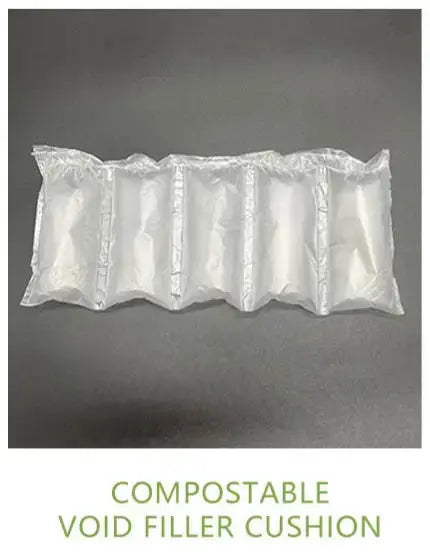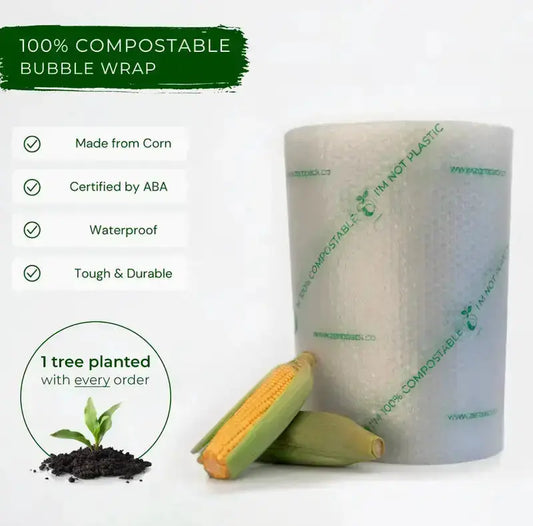Elevate Your Shipping Game: The Ultimate Guide to Eco-Friendly Packaging Air Pillows
In a world increasingly conscious of its environmental impact, businesses are seeking innovative ways to enhance their shipping processes while reducing waste. Enter eco-friendly packaging air pillows, a sustainable solution that not only protects your products during transit but also elevates your brand's commitment to sustainability. These lightweight, inflatable cushions are designed to replace traditional materials like Styrofoam and bubble wrap, providing reliable cushioning without harming the planet. As consumers become more environmentally aware, showcasing your dedication to eco-friendly practices is essential for retaining loyalty and standing out in a competitive marketplace. In this ultimate guide, we'll explore the benefits of eco-friendly packaging air pillows, how to incorporate them into your shipping strategy, and tips for maximizing their effectiveness. Join us as we help you transform your shipping game, making it more sustainable, efficient, and aligned with the values of today’s conscientious consumers. Start your journey toward greener packaging solutions that resonate with your audience and bolster your brand's reputation!
What are Packaging Air Pillows?
Packaging air pillows are a modern and innovative solution designed to protect products during shipping. These inflatable cushions are typically made from recyclable materials and are used to fill voids in shipping boxes, ensuring that items remain securely in place. Unlike traditional packaging materials such as Styrofoam peanuts or bubble wrap, air pillows are lightweight and can be deflated when not in use, making them a space-efficient option for businesses.
The primary function of packaging air pillows is to provide cushioning and support, preventing damage to goods during transit. They can be customized in various sizes and shapes to suit different types of products, from fragile electronics to bulky items. This adaptability makes them a versatile choice for businesses of all sizes and industries. Additionally, the air-filled nature of these pillows means they require significantly less material than other packaging options, contributing to their eco-friendly profile.
One of the standout features of packaging air pillows is their ease of use. They can be quickly inflated using an air pump or machine, and their lightweight nature means they add minimal weight to shipments. This can result in reduced shipping costs and lower carbon emissions, as less energy is required to transport lighter packages. As businesses increasingly prioritize sustainability, packaging air pillows offer a practical and environmentally friendly alternative to conventional packaging materials.
The Environmental Impact of Traditional Packaging
Traditional packaging materials, such as Styrofoam and bubble wrap, have long been criticized for their detrimental impact on the environment. Styrofoam, or expanded polystyrene (EPS), is particularly notorious due to its non-biodegradable nature. It can take hundreds of years to decompose, during which time it can break down into smaller particles that pollute waterways and harm marine life. Additionally, the production of Styrofoam involves the use of toxic chemicals and significant energy consumption, contributing to air and water pollution.
Bubble wrap, while less harmful than Styrofoam, still poses environmental challenges. Made from polyethylene, a type of plastic, bubble wrap is not biodegradable and can contribute to the growing problem of plastic waste. Although some recycling programs accept bubble wrap, it is often not recycled properly due to contamination or lack of facilities. This means that much of it ends up in landfills, where it can persist for hundreds of years, leaching harmful chemicals into the soil and water.
The environmental impact of traditional packaging materials extends beyond waste disposal. The production process for these materials is energy-intensive and relies heavily on fossil fuels, contributing to greenhouse gas emissions and climate change. Furthermore, the extraction and processing of raw materials for packaging can lead to habitat destruction, water contamination, and other ecological problems. As awareness of these issues grows, businesses and consumers alike are seeking more sustainable alternatives to reduce their environmental footprint.
Benefits of Using Eco-Friendly Air Pillows
Eco-friendly packaging air pillows offer numerous advantages over traditional packaging materials. One of the most significant benefits is their reduced environmental impact. Made from recyclable materials and designed to be reused, eco-friendly air pillows help minimize waste and resource consumption. By opting for these sustainable alternatives, businesses can significantly lower their carbon footprint and contribute to the circular economy.
Another key benefit of eco-friendly air pillows is their cost-effectiveness. Although the initial investment in air inflation equipment may be higher, the long-term savings can be substantial. Eco-friendly air pillows are lightweight, which can lead to lower shipping costs due to reduced package weight. Additionally, their ability to be deflated and stored compactly means businesses can save on storage space and handling expenses. Over time, these savings can add up, making eco-friendly air pillows a financially prudent choice.
From a branding perspective, using eco-friendly air pillows can enhance a company's reputation and appeal to environmentally conscious consumers. Today's consumers are increasingly aware of the environmental impact of their purchasing decisions and are more likely to support businesses that demonstrate a commitment to sustainability. By incorporating eco-friendly packaging solutions, companies can differentiate themselves in a competitive marketplace and build stronger relationships with their customers. This can lead to increased customer loyalty, positive word-of-mouth, and a stronger overall brand image.
How Eco-Friendly Air Pillows are Made
The production process for eco-friendly air pillows is designed to be as sustainable as possible. These air pillows are typically made from bioplastics or other recyclable materials, which are derived from renewable resources such as cornstarch or sugarcane. Unlike traditional plastics, bioplastics decompose more quickly and do not release harmful toxins into the environment. This makes them a more sustainable option for packaging.
The manufacturing process begins with the extraction of raw materials, which are then processed into pellets. These pellets are melted and extruded into thin films, which are then blown into inflatable pillows. During this process, manufacturers often incorporate recycled content to further reduce the environmental impact. The resulting air pillows are durable, lightweight, and designed to provide optimal cushioning for shipped products.
One of the key features of eco-friendly air pillows is their ability to be easily deflated and reinflated. This versatility allows businesses to reuse the pillows multiple times, extending their lifespan and reducing the need for constant production. Additionally, many eco-friendly air pillows are designed to be recyclable, meaning they can be returned to the production cycle at the end of their useful life. This closed-loop system helps minimize waste and supports the principles of the circular economy.
Comparing Eco-Friendly Air Pillows to Other Packaging Options
When evaluating packaging options, it's essential to consider the environmental impact, cost, and effectiveness of each material. Eco-friendly air pillows stand out in several key areas compared to traditional packaging materials like Styrofoam peanuts, bubble wrap, and paper-based solutions.
Firstly, eco-friendly air pillows are significantly lighter than Styrofoam peanuts and bubble wrap. This lightweight nature not only reduces shipping costs but also decreases the carbon footprint associated with transportation. Unlike Styrofoam, which is bulky and difficult to dispose of, air pillows can be easily deflated and recycled, making them a more sustainable choice. Bubble wrap, while effective for cushioning, lacks the recyclability and biodegradability of eco-friendly air pillows, making it less environmentally friendly.
Paper-based packaging solutions, such as shredded paper or cardboard inserts, are often considered more sustainable than plastic-based options. However, they have their drawbacks. Paper-based materials can be heavier and bulkier, leading to higher shipping costs and increased carbon emissions. They also may not provide the same level of cushioning and protection as air pillows, particularly for fragile items. Additionally, the production of paper-based packaging involves significant water and energy consumption, which can offset some of the environmental benefits.
In terms of cost, eco-friendly air pillows can offer significant savings over time. While the initial investment in air inflation equipment may be higher, the lightweight nature of air pillows can lead to reduced shipping costs. Furthermore, their ability to be reused and recycled means businesses can save on material costs in the long run. Overall, eco-friendly air pillows provide a balanced solution that addresses environmental concerns, cost efficiency, and effective product protection.
Tips for Choosing the Right Eco-Friendly Air Pillows
Selecting the right eco-friendly air pillows for your business involves considering several factors, including the size and weight of your products, the level of protection required, and your budget. Here are some tips to help you make an informed decision:
-
Assess Your Packaging Needs: Start by evaluating the types of products you ship and their specific packaging requirements. Fragile items may need more cushioning, while lightweight products may only require minimal padding. Understanding your needs will help you choose the right size and type of air pillows.
-
Consider Material and Recyclability: Look for air pillows made from recyclable or biodegradable materials. Check if the manufacturer uses recycled content in their production process. Choosing eco-friendly materials will help reduce your environmental impact and align with your sustainability goals.
-
Evaluate Costs and Savings: While eco-friendly air pillows may have a higher initial cost, consider the long-term savings. Calculate potential reductions in shipping costs due to the lightweight nature of air pillows and factor in savings from reduced storage space and handling expenses. Investing in quality inflation equipment can also provide a good return on investment over time.
-
Test for Performance: Before committing to a large purchase, conduct tests to ensure the air pillows provide adequate protection for your products. Check for durability, ease of use, and effectiveness in cushioning. This will help you avoid potential damage during transit and ensure customer satisfaction.
-
Vendor Reliability: Choose a reputable supplier who can provide consistent quality and reliable customer support. Research the vendor’s sustainability practices and commitment to eco-friendly production. A reliable supplier will help you maintain a steady supply of high-quality packaging materials.
-
Customization Options: Some suppliers offer customization options, allowing you to brand the air pillows with your company logo or specific messaging. This can enhance your brand visibility and reinforce your commitment to sustainability with your customers.
Case Studies: Businesses Successfully Using Eco-Friendly Packaging
Numerous businesses across various industries have successfully integrated eco-friendly air pillows into their shipping processes, reaping the benefits of sustainability and cost efficiency. Here are a few examples:
Case Study 1: EcoTech Electronics
EcoTech Electronics, a manufacturer of high-end electronic devices, faced challenges in protecting their fragile products during shipping. Traditional Styrofoam packaging was not only environmentally harmful but also bulky and expensive. By switching to eco-friendly air pillows made from biodegradable materials, EcoTech significantly reduced their packaging waste and shipping costs. The lightweight air pillows provided excellent cushioning, ensuring that their products arrived undamaged. This change also resonated with their environmentally conscious customer base, boosting brand loyalty and sales.
Case Study 2: GreenGrocery Co.
GreenGrocery Co., an online organic food retailer, was committed to minimizing their environmental impact. They replaced conventional bubble wrap with recyclable air pillows for their shipments. The transition not only reduced their plastic waste but also improved the efficiency of their packing process. The air pillows were easy to inflate and provided superior protection for delicate food items. Customers appreciated the sustainable packaging, leading to positive reviews and increased repeat business.
Case Study 3: FashionForward Boutique
FashionForward Boutique, an online clothing retailer, wanted to enhance their packaging while maintaining their commitment to sustainability. They opted for customized eco-friendly air pillows featuring their brand logo. This not only protected their products but also provided a unique unboxing experience for customers. The eco-friendly packaging reinforced their brand values and led to increased customer satisfaction and loyalty.
Implementing Eco-Friendly Practices in Your Shipping Process
Transitioning to eco-friendly air pillows is just one aspect of creating a sustainable shipping process. Here are some additional steps you can take to further reduce your environmental impact:
-
Optimize Packaging Design: Design your packaging to minimize waste and use materials efficiently. Choose the right box size for your products to reduce the need for excessive cushioning. This can also lower shipping costs and decrease your carbon footprint.
-
Use Recyclable and Biodegradable Materials: In addition to eco-friendly air pillows, consider using other recyclable or biodegradable packaging materials, such as paper tape, compostable mailers, and recycled cardboard. Ensure that all materials used in your packaging are clearly labeled for recycling.
-
Implement a Recycling Program: Encourage your customers to recycle packaging materials by providing clear instructions and information on how to do so. Consider offering incentives for customers who return packaging for reuse or participate in recycling programs.
-
Reduce Single-Use Plastics: Minimize the use of single-use plastics in your shipping process. This includes avoiding plastic bags, zip ties, and other non-recyclable items. Opt for reusable or biodegradable alternatives whenever possible.
-
Educate and Train Staff: Ensure that your employees are knowledgeable about sustainable packaging practices and understand the importance of reducing waste. Provide training on proper packing techniques to maximize the effectiveness of eco-friendly air pillows and other materials.
-
Monitor and Measure Progress: Track your packaging materials usage, waste generation, and recycling rates to measure the impact of your sustainability efforts. Use this data to identify areas for improvement and set targets for further reducing your environmental footprint.
Conclusion and Future Trends in Eco-Friendly Packaging
As businesses and consumers become more environmentally conscious, the demand for sustainable packaging solutions will continue to grow. Eco-friendly air pillows represent a significant step forward in reducing the environmental impact of shipping and packaging. By adopting these innovative solutions, businesses can protect their products, reduce waste, and demonstrate their commitment to sustainability.
Looking ahead, we can expect to see further advancements in eco-friendly packaging technologies. Innovations in bioplastics, compostable materials, and renewable resources will likely lead to even more sustainable and effective packaging options. Additionally, increased awareness and regulatory measures around plastic waste and environmental conservation will drive the adoption of greener packaging practices across industries.
In conclusion, eco-friendly air pillows offer a practical and sustainable alternative to traditional packaging materials. By incorporating them into your shipping process, you can enhance your brand's commitment to sustainability, reduce costs, and meet the evolving expectations of today's environmentally conscious consumers. Embrace this opportunity to elevate your shipping game and contribute to a greener future for our planet.
















0 comments